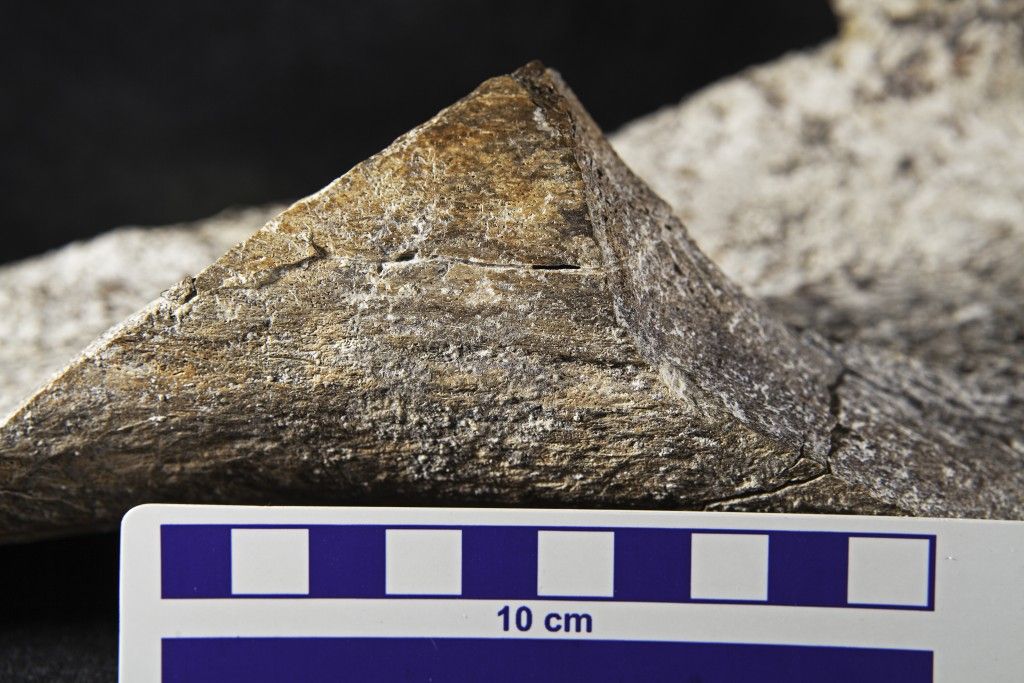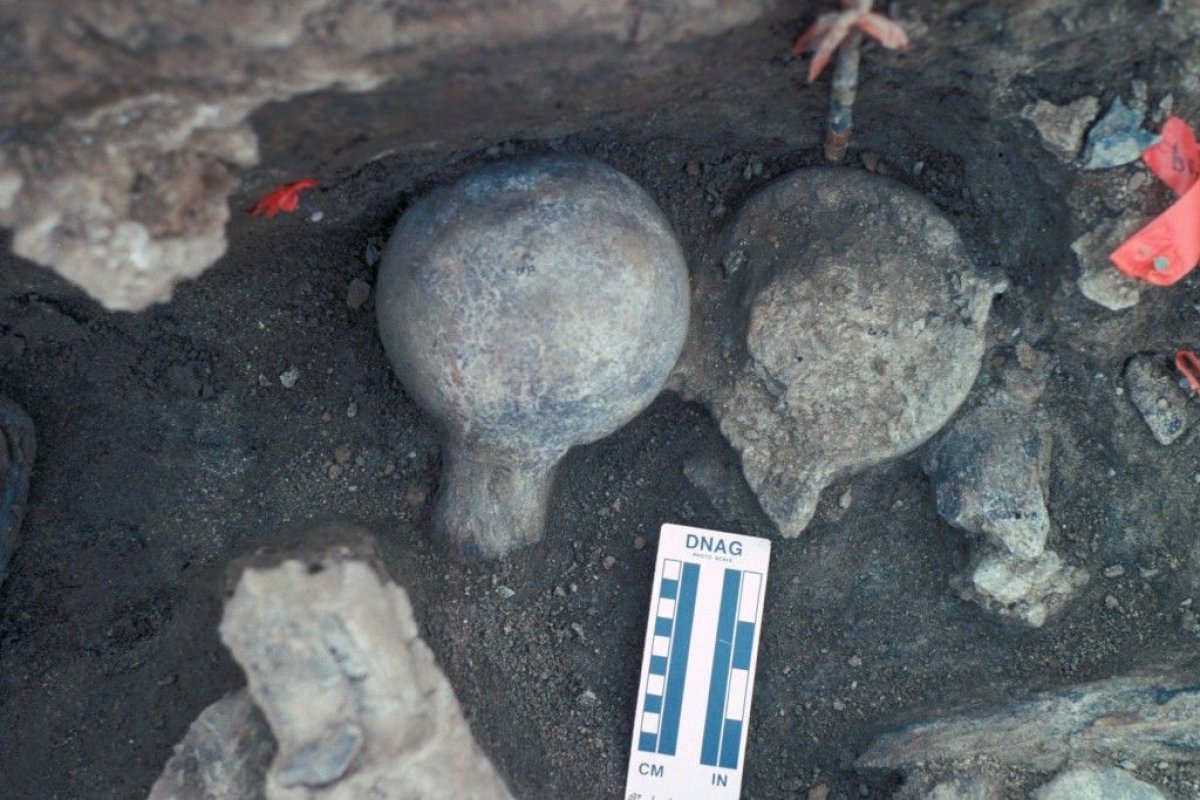
A mysterious species of early human appears to have made it to the U.S. at least 100,000 years before previously thought, scientists announced Wednesday. The discovery of a set of animal bones that appears to have been butchered by early humans potentially overthrows decades of archaeological evidence—raising major questions about how and when our first ancestors got to the Americas.
During the construction of a California highway in 1992, experts from the San Diego Natural History Museum carrying out routine paleontological monitoring of the site uncovered an archaeological site. Researchers found the bones of a mastodon—an extinct elephant-like creature. The bones had been unusually positioned alongside a set of tools known to have been used by early humans, including hammerstones and stone anvils. At the time, however, scientists were not able to accurately date the bones, so their significance was unclear.
Now, using advanced uranium–thorium dating techniques, scientists have been able to work out when the mastodon lived. Their findings, published in Nature, showed it was 130,000 years ago—115,000 years before scientists thought humans first made it to the United States.
First humans in the Americas?
At present, the most widely accepted theory of how and when humans first came to America is via the Bering Land Bridge at least 15,000 years ago. This land bridge joined Siberia and North America and is believed to have provided a migration route for early humans and animals, before it disappeared toward the end of the last Ice Age, about 12,000 years ago. However, there isn't much fossil evidence of early humans in the Americas, so the exact route into the U.S. is debatable.
So what have scientists found and why does it point to a much earlier migration? The mastodon bones and teeth unearthed at the site had been broken in a very specific way. Spiral fractures along some of the limb bones indicate they had been broken shortly after the animal had died. Its teeth appeared to have been hit with hard objects. Because of the presence of the stone tools and the positioning of the bones, researchers believe the mastodon was butchered at the site. They say whoever processed the bones was doing so to make tools and to extract the marrow.
The authors, led by Thomas Deméré of the San Diego Natural History Museum, California, do not know which species of hominin might have been responsible for the butchered bones. Because there was no evidence of human remains at the site dating to this time, establishing this will be difficult.
Regardless, the team said the evidence is enough to say humans were present in the U.S. 130,000 years ago. Speaking at a press conference, Deméré said: "While the association of extinct megafauna and humans is exciting in itself, it's the 130,000 year-old age of the site is the most extraordinary result of our research. This makes it the oldest archaeological site in the Americas—older by a factor of 10 when we consider that currently the oldest widely accepted date of human presence in the New World is 14-15,000 years ago. Of course, extraordinary claims like this require extraordinary evidence and we think the mastodon site preserves such evidence."
Remarkable evidence
After ruling out other possible explanations for the site, including natural geological processes, other animals and damage caused by the construction work that led to its discovery, the team carried out experiments to show how humans could have broken the bones in the way they were found.
They conducted two experiments on elephant bones, using tools comparable to the anvil and stonehammer discovered at the site. They found the same fracture patterns emerged as those seen on the mastodon bones, suggesting humans were responsible for making them.
Richard Fullagar, who studied the tools at the site, said: "What's significant about this site is you can actually identify a particular hammer that was smacked on a particular anvil in a bunch of broken bones and fragments of those hammers and anvils can be refitted to the stones. It's very rare you get the whole package together at one site. The evidence at the site is truly remarkable and really does demonstrate human interference in there. And you've got varying lines of evidence, from paleontology and from archaeological study of the artifacts. The dates are remarkable, but it's hard to argue with the clear evidence we can see in all this material."

How would they have got there?
The authors of the study make it clear they do not know what species of hominin might have made it to the Americas at such an early point in time. Nor do they know how they would have got to the site.
Study author Steven Holen said: "We think there are two possibilities on the route humans used to get to North America. The first is that they came across the Bering Land Bridge—they would have had to come in before 130,000 years ago, which is an interesting date because that's how old the site is. The Bering Land Bridge was inundated by rising sea levels around 130,000 years ago so humans could not have got in by land after that for quite a few thousand years."
"The other possibility is by water. We now have evidence from quite a few places across the world that early humans were using watercraft quite early. For example, on the island of Crete they have found hand axes in geological deposits that are 130,000 years old. There's never been a land bridge to Crete and you have to cross quite a few kilometers of land to get there, so they must have had some sort of watercraft to get there. The same in Southeast Asia in the island of Sulawesi in Indonesia. People arrived there sometime between 118,000 and 190,000 years ago. They must have had some sort of watercraft to get there.
"Early humans could have used watercraft and followed the coast of Asia north then along the southern coast of the Bering Land Bridge and crossing a short distance of water if the land bridge was already breached. Then they could have used watercraft to come down the west coast of North America to California quite early."

Huge skepticism
The findings have been met with skepticism within the scientific community. The lack of human remains, plus the wealth of evidence suggesting a far later arrival has left many questioning the results.
María Martinón-Torres, Lecturer in Paleoanthropology at UCL, U.K., tells Newsweek in an email interview that at the moment, there is not enough evidence to draw any solid conclusions about the presence of humans in the U.S. so long ago. "In general I think it would be good to be prudent and wait for more evidence," she says. "We have some fresh fractures but no evidence of cutmarks—that is, proper defleshing. Also we do not have knapped tools but some cores and stones that could have potentially worked as hammerstones and anvils," she said, referring to the process of fracturing stone to create tools.
"If it were Homo sapiens I would expect to find more sophisticated tools and behaviour. It is surprising to not find more elaborated tools or cutmarks for processing the meat. If it were a more archaic hominin then we would be assuming that they were able of moving up to Beringia or crossing the Pacific, something that to our knowledge only H. sapiens did about 100,000 years later."
"To my knowledge, this is the first and only evidence suggesting something like this, so it would be important to be prudent before drawing conclusions. Even if it were Homo neanderthalensis or Homo erectus, the type of marks and tools left behind would be more elaborated an unequivocal.
"I think that the taphonomic study [examining decaying organisms over time] here is crucial and it is necessary to discard other agents, perhaps other animals, as responsible for the accumulation and fresh fracture of the mastodon."
Iain Morley, academic coordinator at the University of Oxford's School of Anthropology & Museum Ethnography, said via email to Newsweek that the authors present strong arguments that the damage to the stones and bones was caused by human or hominin activity.
"If the authors' interpretation of the material is correct, the hominins in question would likely be 'archaic' humans rather than modern Homo sapiens, as we have no unambiguous evidence of Homo sapiens east of the Levant at this time (130,000 years ago)—and they would have had to access the Americas from eastern Asia and a land-bridge between Asia and the Americas (so-called Beringia). Evidence shows that late descendants of Homo erectus (perhaps including so-called Denisovans) lived in eastern Asia at that time so could be good candidates.
"We should also bear in mind that this evidence comes from Southern California, a long way south—which would suggest that corroborating evidence might be expected to exist—and come to light in due course—in locations between there and north-west America/Bering Strait, since these populations and their ancestors would have had to expand through these intervening regions."
The study authors said they expect a certain level of skepticism and invite scholars to analyze the evidence further. Next, they plan to look through other archaeological material in the archives to see if they can find additional evidence of humans in the Americas at this time.
Uncommon Knowledge
Newsweek is committed to challenging conventional wisdom and finding connections in the search for common ground.
Newsweek is committed to challenging conventional wisdom and finding connections in the search for common ground.
About the writer
Hannah Osborne is Nesweek's Science Editor, based in London, UK. Hannah joined Newsweek in 2017 from IBTimes UK. She is ... Read more
To read how Newsweek uses AI as a newsroom tool, Click here.








